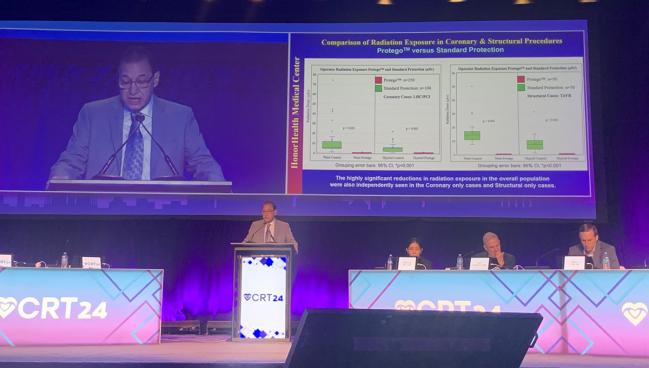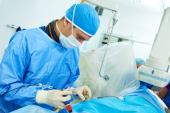Comprehensive Radiation Shield Sharply Cuts Operator Exposure
Some mid- and late-career operators have had the equivalent of 10,000 to 50,000 chest X-rays to the face, says David Rizik.

WASHINGTON, DC—A comprehensive radiation shield can cut radiation exposure to primary operators during coronary and structural heart procedures by more than 99% when used in combination with standard safety measures, data presented here at CRT 2024 suggest.
With the use of the system, known as Protego (Image Diagnostics), a busy interventionalist could perform about 400 cases and be exposed to less than 1% of the Occupational Safety and Health Administration’s maximum annual allowable radiation exposure threshold, said David Rizik, MD (HonorHealth, Scottsdale, AZ), in his presentation.
“Performing a thousand cases, based on our data would mean exposure to less than 2% of the recommended limit,” he added.
Turning to the audience during the presentation, Rizik noted that there were likely many mid- and late-career operators out there who, depending on their yearly case loads, may have received “the equivalent of 10,000 to 50,000 chest X-rays to the face over a career.”
Panelist Giorgio Medranda, MD (Langone Hospital, Glen Cove, NY), noted “this is a very important topic in the field, especially for us younger guys.”
Making the cath lab safer for younger physicians, especially for those of reproductive age, is one goal of this type of radiation protection system, Rizik said.
“Studies have shown that women cardiologists have expressed hesitancy about going into one of the fluoroscopy specialties, whether interventional cardiology or electrophysiology, and the number one reason that they cite is concern over radiation exposure during the childbearing years,” he added. “We have done a very poor job at addressing this, [and] for so many reasons, it's time that we take this head on and make it our primary objective—a moral imperative, quite frankly—that we reduce radiation in the cath lab to zero.”
Less Radiation at Waist and Thyroid
The study included 350 nonconsecutive patients from a single center who underwent a coronary intervention and 100 who had a structural heart intervention. Operators used the Protego system at their discretion, resulting in 250 uses in the coronary group and 50 uses in the structural group, with the remaining cases serving as controls. Standard protection measures consisted of a 0.5 mm lead apron, thyroid collar, and leaded glasses, plus a ceiling drop-down shield.
Regardless of whether the operator used the Protego system or not, their radiation exposure was measured via real-time dosimeters outside the lead apron at the waist and thyroid.
The Protego system consists of an upper shield connected to the table to facilitate panning, plus a lower shield and accessory side shield, as well as a flexible radiation drape for the patient, and an arm board with built-in radiation drapes for radial access.
Compared with standard protection alone, use of the Protego system was associated with lower radiation exposure at the operator’s thyroid (0.63 µSv vs 66.4 µSv; P < 0.001) and waist (0.33 µSv vs 142.5 µSv; P < 0.001). The reductions in radiation exposure were similar regardless of whether procedures were coronary or structural.
Additionally, even with longer fluoroscopy times in coronary procedures and higher dose area product (DAP) in the Protego group, there was less operator radiation exposure compared with standard protection (P = 0.015 and P < 0.001, respectively).
According to Rizik, the protective capabilities of the system for peripheral vascular and electrophysiology procedures still require further evaluation.
“Whether the routine use of Protego in lieu of lead aprons will reduce occupational maladies such as orthopedic injury is the focus of ongoing study,” Rizik added.
Co-moderator Wah Wah Htun, MD (Gundersen Health, Lacrosse, WI), pointed out that while operator safety is an important goal, other members of the team who are in the room should receive equal protection from radiation exposure while performing their jobs.
Rizik said protection for collaborating members of the heart team, specifically the echocardiographers and anesthesiologists who are at highest radiation exposure risk during structural cases, will require shielding adaptations to assure adequate protection.
“Iterative advances will be needed in all of the technologies to make sure that their radiation exposure is as close to zero as possible,” he commented to TCTMD, adding that making that achievable for everyone in the cath lab is the next important step in radiation safety research for interventional cardiology.
L.A. McKeown is a Senior Medical Journalist for TCTMD, the Section Editor of CV Team Forum, and Senior Medical…
Read Full BioSources
Rizik DG. Comprehensive radiation shield minimizes operator radiation exposure in coronary and structural heart procedures. Presented at: CRT 2024. March 12, 2024. Washington, DC.
Disclosures
- Rizik reports no relevant conflicts of interest.






Comments